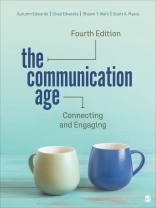When should you send a text message, and when is it more appropriate to talk face-to-face? What is the best way to prepare for a job interview that will be conducted over video? How should you modify your speech if it will be recorded and posted online?
The Communication Age: Connecting and Engaging introduces students to the foundational concepts and essential skills of effective communication, with a strong emphasis on the impact of technology in our increasingly interconnected world.
This new
Fourth Edition helps students become involved in our diverse global community and learn how to apply key principles of effective communication—whether incorporating media, technology, or traditional face-to-face speech communication—to foster civic engagement for a better future. With comprehensive coverage of the essentials of interpersonal, small group, and public communication, this text is ideal for use in hybrid introduction to communication courses.
Inhoudsopgave
Chapter 1. Communication in the 21st Century
The Communication Age
What Is Communication?
Contexts of Communication
Communication Metaphors
Communication Ethics
Connecting and Engaging in Communication
Chapter 2. Perception, Self, and Communication
Perception and Communication
Selection and Communication
Influences on Perception
Self and Communication
Perception, Self, Communication, and Convergence
Chapter 3. Verbal Communication
Verbal Versus Nonverbal Communication
Functions of Verbal Messages
Production and Interpretation of Verbal Messages
Verbal Communication and Convergence
Chapter 4. Nonverbal Communication
Why Does Nonverbal Communication Matter?
Functions of Nonverbal Communication
Codes of Nonverbal Communication
Improving Your Nonverbal Communication Skills
Nonverbal Communication and Convergence
Chapter 5. Listening
Hearing Versus Listening
Listening Problems
Benefits of Being a Good Listener
Types of Listening
Becoming a Better Listener
Listening and Convergence
Chapter 6. Communication, Culture, and Diversity
Culture and Diversity Defined
Cultural Awareness
Cultural Competence
Examples of Diversity Across Communication Contexts
Barriers to Communication, Culture, and Diversity
Communication, Culture, Diversity, and Convergence
Chapter 7. Interpersonal Communication
Forming Relationships
Models of Relationship Formation
Communication of Interpersonal Relationships
Interpersonal Communication and Convergence
Chapter 8. Small Group and Team Communication
What Is Small Group Communication?
Small Group Development
Small Group Member Roles
Small Group Leadership
Small Group Conflict
Small Group and Team Communication and Convergence
Chapter 9. Workplace and Organizational Communication
What Is Workplace Communication?
Workplace Culture
Workplace Socialization
Workplace Supervisory Relationships
Workplace Coworker Relationships
Workplace and Organizational Communication and Convergence
Chapter 10. Communication and New Media
Communication Traditions and Technology
New Media: Connecting and Engaging
Characteristics of New Media Theory
Presenting Your Online Identity
New Media as Your Community
New Media and Convergence
Chapter 11. Selecting and Researching Your Topic and Knowing Your Audience
What Is the Purpose and Type of Your Presentation?
How to Select a Topic and Analyze Your Audience
Plagiarism
Building Credibility With Research
The Basics of Your Presentation
Selecting and Researching Your Topic and Knowing Your Audience and Convergence
Chapter 12. Organizing Your Presentation
Telling a Story
Organizational Patterns
The Various Parts of the Presentation
Outlines
Time Considerations
Organizing Your Presentation and Convergence
Chapter 13. Delivering Your Presentations
How to Reduce Your Anxiety and Fear Over Presentations
Methods of Delivery
Effective Delivery Skills
Multimedia Presentational Aids
Ways to Present Your Multimedia Presentational Aids
Delivery in Presentations and Convergence
Chapter 14. Informative Presentations
The Difference Between Informative and Persuasive Presentations
Relating Your Topic to the Audience
Types of Informative Presentations
Strategies for Informative Presentations
Samples of Informative Presentations
Informative Presentations and Convergence
Chapter 15. Persuasive Presentations
Types of Persuasive Claims
Crafting Persuasive Arguments
Strategies to Persuade
Organizing Your Persuasive Presentation
Samples of Persuasive Presentations
Persuasive Presentations and Convergence
Over de auteur
Scott A. Myers (Ph D, Kent State University) is a professor and Peggy Rardin Mc Connell Chair in the Department of Communication Studies at West Virginia University (WVU) where he teaches courses in instructional communication, organizational communication, and communication pedagogy. His research interests center primarily on the student-instructor relationship in the college classroom and the adult sibling relationship, with his research appearing in outlets such as Communication Education, Journal of Family Communication, Communication Research Reports, and Communication Quarterly, among others. At WVU, he was recognized by the Eberly College of Arts and Sciences as a Woodburn Professor (2005–2007) and as an Outstanding Teacher in 2010. He is a former editor of Communication Teacher, a former executive director of the Central States Communication Association (CSCA), and a past president of CSCA.












